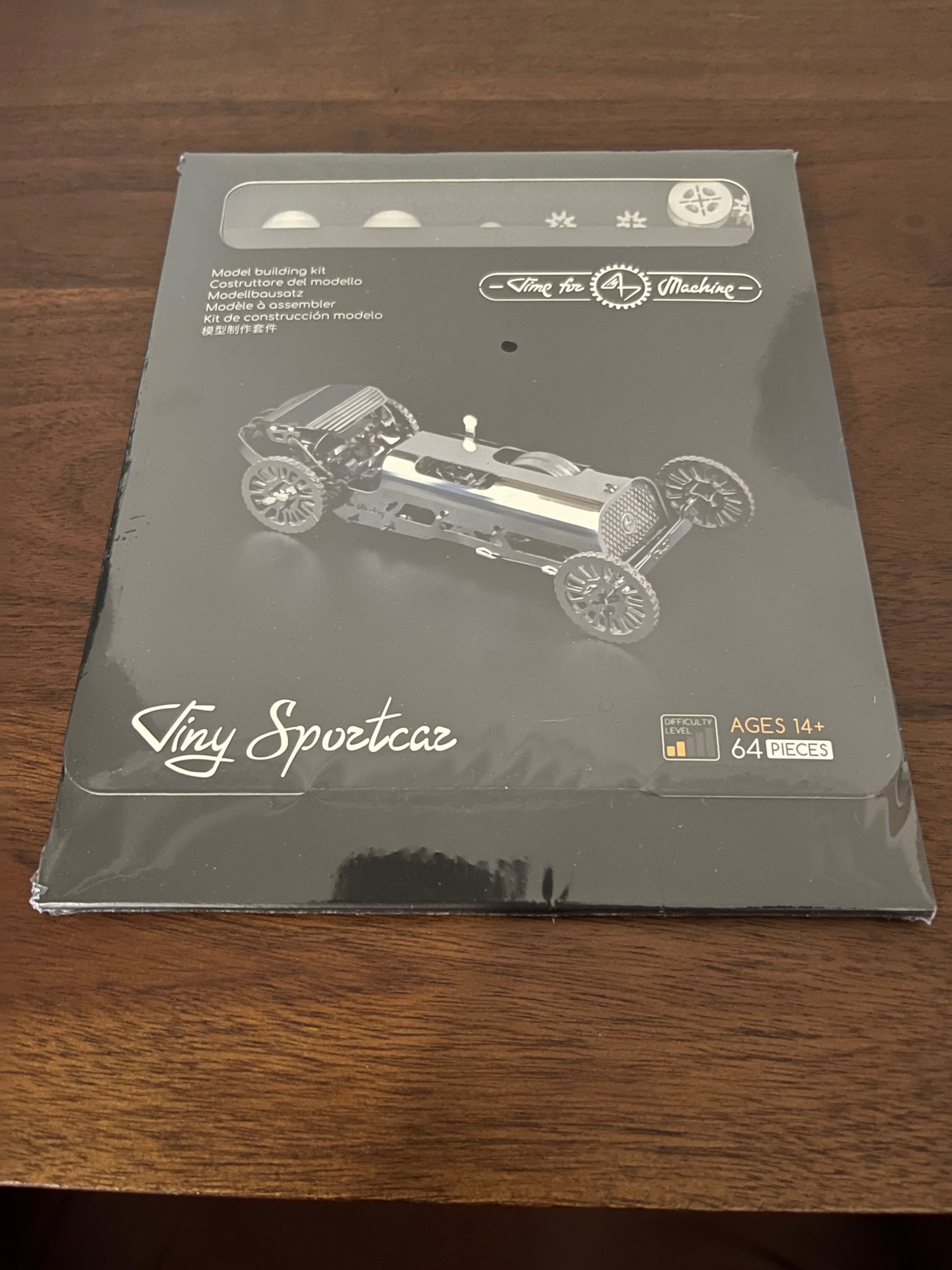TimeForMachine Metal Model Review
Cover image source: www.timeformachine.fr
When I was younger my main interest was pretty simple: video games.
I have exceedingly fond memories of growing up in the period between the 16 and 64 bit eras, but even though I’m happy with that part of my childhood I wish I’d been aware enough to have just a bit more balance in my life.
That’s very easy to say as an adult; as a child I think you just tend to pursue what seems more fun at a given moment. Still, I’m always a little jealous of people who have stories like:
“From a young age I’d take everything apart to see how it worked”, or
“I started early with Legos and by age 15 I was building radio-controlled submarines out of Technic kits”.
The truth is, the few times I was given a Technic kit I’d usually just bug my parents to make it for me so I could play with it later (before then quickly firing up the video games!).
This is quite embarrassing for me to say, but I am somewhat redeemed now because it turns out I must have somehow had some deeply buried interest in this type of pass-time. When school became more serious and thoughts turned towards a major in college, I couldn’t think of anything more exciting than working on cars or airplanes, so mechanical engineering was a natural choice.
Fast forward past graduation, and I realized that “hey, even though I’m an adult, this Technic stuff is pretty fun!”. My disposable income went to some kits, and then of course that fully-blossomed passion for mechanical devices turned into a decade-plus obsession with (addiction to?…) mechanical watches.
I still find time for retro-gaming, but over the years I’ve made up for my lopsided childhood by tinkering with various projects far more than blasting aliens or saving princesses; I’ve messed with Raspberry Pies, tried my hand at leather-working, and even taken an online watch-assembly course.
To this day, and perhaps even more so because my day-job does not have me building anything remotely physical, I’m always on the lookout for relatively short, satisfying projects that both teach me something and leave me with something cool-looking at the end.
Recently, the latest project to pique my interest came from company called TimeForMachine.
I usually write very, very long articles, but for this one there is a clear punchline:
TL; DR: The idea itself is clever and while the end-products certainly look cool, I found the execution to lead to a deeply frustrating build experience, and I say that as someone with years of “tinkering” under my belt. I was looking forward to populating my bookshelf with more complex models, but presently I cannot in good conscience recommend these kits.
Read on for more details…
Thanks Instagram!
Like many people, I have a conflicted relationship with social media. On one hand I live in the world that social media has led to, but on the other hand for me as an individual its use has absolutely been a net positive. With social media, I’ve fine-tuned my style, learned a ton about watches, and even learned how to play the guitar.
Instagram in particular I find to be a lot of fun to use because it seems as if I’m discovering some fun new thing daily, and that is what happened recently with TimeForMachine. As you would expect during the holiday season, my feed is full of ads, but these shiny machines really caught my attention (and it probably helped that the TimeForMachine team chose to use the top-of-the-line remote controlled tank model in the ads).
Since the company was running a 35% off Black Friday Week sale, I opted for the entry-level Tiny Sportcar, just to make sure this was something I was really into before committing (wasting…) more money.
The total came out to about 17 euros, and while waiting for the package to arrive I did a little bit more research.
The reviews of TimeForMachine, the company, are…mixed
I’m not talking about reviews of the products, I’m talking about reviews of the company itself. The “.com” Trustpilot has an average score of 3.1 over 47 reviews and has people writing things like:
“AVOID AT ALL COSTS.
Poorly designed models that doesn't even work properly. If you contact them after purchasing the product, all they say is "That is what you have paid for."
Check their websites and product listings for reviews. I bet there are no negative reviews as they block, delete and manage their reviews.”
TimeForMachine apparently started as a Kickstarter project, and while it certainly wouldn’t be the first crowdfunded project to be somewhat “flaky”, I was interested to find that the French Trustpilot page has an average of 4.5 over 128 reviews, with reviewers generally praising the product and customer service, though one does state this is difficult even for those with experience (more on that later).
I live in France and did not experience any issues with my first order, it was expedited very quickly and arrived two days later (my second order was also dispatched very quickly, I bought it thinking I could jump to it immediately after the Tiny Sportcar, but - spoiler alert - I will not be doing this).
To the extent most of the bad reviews were regarding operations, I felt I had done pretty well to get a kit on time, and in good condition. The weekend after I got my package I had a chance to sit down with the model, and that’s when the trouble started.
In my day-to-day life I’ve never heard much about Ukrainian companies so I was interested to see this note on the box. Regardless of my thoughts on this product, I hope everyone at the TimeForMachine team is safe!
The concept is pretty clever, but what problem is it solving?
The idea of “flat-packing” is nothing new, and though we may dread having to build a piece of Ikea furniture, we’ve just come to accept this as a necessary evil in exchange for nicely designed (if that design language is your thing) furniture at a much cheaper cost than buying it ready-made.
To the credit of Ikea, the idea is pretty brilliant: by flat-packing what would otherwise be an extremely cumbersome item, they get to save on costs all the way down the value chain.
Where TimeForMachine differs from Ikea is that with the latter, you are taking three-dimensional pieces such as brackets and wheels and assembling them into a larger three-dimensional structure. With TimeForMachine kits, EVERYTHING is totally flat, and it is then up to you to bend and manipulate these pieces to obtain the intended machine at the end.
In theory, you are supposed to build that rad-looking 3D car from this completely flat package of parts.
This is the 0.35 mm-thick sheet of parts that are supposed to lead to your finished model.
Though the parts-set above might look very similar to that of traditional models, the key difference here is that, again, everything is flat. In a traditional airplane model for instance, you might be given two halves of a fuselage which you then have to snap and glue together; in a TimeForMachine model, you’d be given two flat parts that you have to fold/roll yourself and then bind together with their attachment system (which I’ll get into later).
Yes, the idea seems pretty clever on paper (in metal?), but is this a problem that really needed to be solved? Did traditional model kits really take up so much space that flat-packing them and putting the onus of shaping the parts on the builder have to happen?
My guess is that the creators liked the idea of shiny metallic models, and in the pictures they do turn out nicely, so I was very excited to get started on my own build.
Things start off well, with clear instructions
Since I mentioned Ikea earlier, this is a good time to mention the company again with regards to its instructions. I mean, they’re supposed to walk you a build through step by step, but a lot of the time they seem like vague indications of what you might want to try.
If you have ever felt you were nearly done with a piece of Ikea furniture and found you had to start over because you mis-oriented a piece, you are not alone!
Perhaps TimeForMachine anticipated those doubts, because they uploaded a series of “build” videos on their YouTube channel, and luckily for me - at least that’s what I thought - there was one for the Tiny Sportcar model I’d set out to build.
Build video for the Tiny Sportcar from TimeForMachine.
In summary: don’t watch these videos.
The thought is nice, but the builders in these videos are clearly experts, and from what I could tell before I stopped watching, there are no closeups. As a result, the videos move fast and don’t give you any added value over the printed instructions, other than indicating a rough idea of how long each model should take to finish…IF you are an expert builder.
I recommend just starting off with the printed instructions, which are clear but still require quite a bit of thought and patience on your part.
What I like about the instructions is that the parts used for each step are colored in green, so unlike in the videos, you know exactly what parts correspond to each step; as long as you make sure to orient your parts grid in the same way as the instructions, you’ll be able to quickly pick out everything you need.
I do wish that rather than keeping the grid representation “as-is” and changing which parts are green, that TimeForMachine had just removed the used parts from the drawing. By doing this, the grid you’re working with would look exactly like the grid in each step of the instructions (meaning with parts missing), and it would be even easier to make sure you’re tracking along correctly.
If you’re used to Ikea furniture, this will look familiar to you. I only wish that grid at the top left would also remove parts as the instructions progress, rather than just shifting the green color to the subsequent, necessary parts.
Once you start building, the problems with the setup become immediately apparent.
First, the parts are 0.35 mm thick (thin?) and so you have to be exceedingly careful when you are detaching them; metal fatigue is absolutely a concern, and if you break a part early on, well, that’s it, your “fun” is over.
The second problem is related to the first, in that you have almost no margin of error. You had better hope you read the instructions correctly and put the pieces together properly, because not only is it very difficult to get the components apart due to their size, you also have to be cautious not to bend them too much while you’re doing this, otherwise you get metal fatigue, and then fatigue failure.
This brings us, finally, to the connection system I’ve been alluding to but haven’t yet fully covered. The parts are designed in such a way as to create tabs that are either to be folded or twisted to lock pieces in place. At first, the tabs were tiny but I could still work with them; towards the end I kept thinking I’d made an assembly mistake because the tabs were even smaller, to the point of almost not being foldable.
I did make a mistake early on, and what a process it was to untwist/fold everything then try again later, while hoping that I had not “exhausted” all my metal life which would cause a part failure on the second attempt!
If you thought putting parts together sucked, try shaping them first…
If folding and twisting tabs weren’t enough, you have to go from 2D to 3D by folding certain parts before they are to be mated. These parts do have very tiny creases where the folds are supposed to occur, but there are issues here also:
Again, you’d better hope that you follow the instructions correctly and fold your parts properly the first time, otherwise you risk metal fatigue. You will see in the upcoming picture that some of the folds required are absolutely ridiculous, taking place in more than one plane, then requiring you to fold other parts to lock an assembly together.
Given the tiny size of each part, it is almost impossible to get a crisp fold. This means that your part is misshapen, which leads to difficulties mating it to others, which then leads to more problems downstream, which either yield an ugly model, or…
Not gonna lie, I rage-quit
Look at the step in the picture below, and try and imagine what’s going on. You have to take a flat part, fold it in several different directions, thread a tiny “washer” thing over the tabs, and then fold the tabs down in opposite directions to lock everything together.
WTF.
This would be frustrating enough if you got it right the first time, but I was so focused on - and frustrated by - the folding, that I forgot the washers.
I then had to attempt to undo everything, which I managed to do, but then trying (and failing) to get the washers over the now hella-janky tabs was the breaking point for me.
This was the step that did it for me; there will be no subsequent TimeForMachine builds.
Usually, I do my best to complete the projects I start. I may not go beyond a project to try to reach skill mastery, but if I start a project, I at least want to finish that small piece of work so I can assure myself that I gave it my best shot.
Not with this.
As I was trying to apply the washer over the mangled tabs with my Swiss Army Knife’s tweezers, I had a thought:
“This isn’t fun, it’s just really frustrating. I have limited free time and there are several other more fun things I could be doing right now.”
So I just picked everything up, tossed it into the recycling bin, and fired up my SNES Mini.
“Frustrating” can be fun…
If it’s fair.
Perhaps coincidentally, that SNES Mini comes with a ROM of Super Ghouls ‘n Ghosts, which is known to be brutally hard.
It is indeed brutally hard, but it’s fair in the sense that if you die, you are convinced that it’s not a flaw in the game, but rather that you just need to play more and get better; when you do manage to beat a given challenge, you feel that your persistence and skill have been rewarded.
That’s why this particular game is loved and hated by the gaming community, and speaking from personal experience, though I’ve died hundreds of times, I keep coming back for more because I love the challenge.
That is not what I felt with the TimeForMachine model: this is not a well-designed challenge, it’s frustrating because it’s flawed.
Though I still do play the occasional retro game, I am a long way from putting video games over everything. At this point in my career/life, I’ve put together assemblies as large as oil tools and as small as watch movements (with some Raspberry Pi and Google Glass thrown in), so I feel good about my ability to build things.
Yet, that still didn’t stop me from throwing in the towel on my trial run with TimeForMachine.
The unfortunate thing is that the models themselves have potential: the “chrome” look is really nice, as are the models themselves (even if some are a bit too “steampunk” for my taste).
I’d be willing to try these again if TimeForMachine considered two changes:
Shipping these models not as total “flat-packs”, but going the route of traditional modeling kits and having components pre-shaped
Lengthening the tabs so that putting pieces together (and perhaps having to take them apart) is not so difficult
With these two modifications, you’d have modeling kits that looked great, and could be constructed with just a pair of needle-nose pliers (and therefore without the mess of glue).
As things stand, if you’re trying to develop your patience and/or anger management, this might be a good tool for that (though these models could also make those worse for you…).
If you’re just looking for something fun to build and display, stick with Lego Technic.







